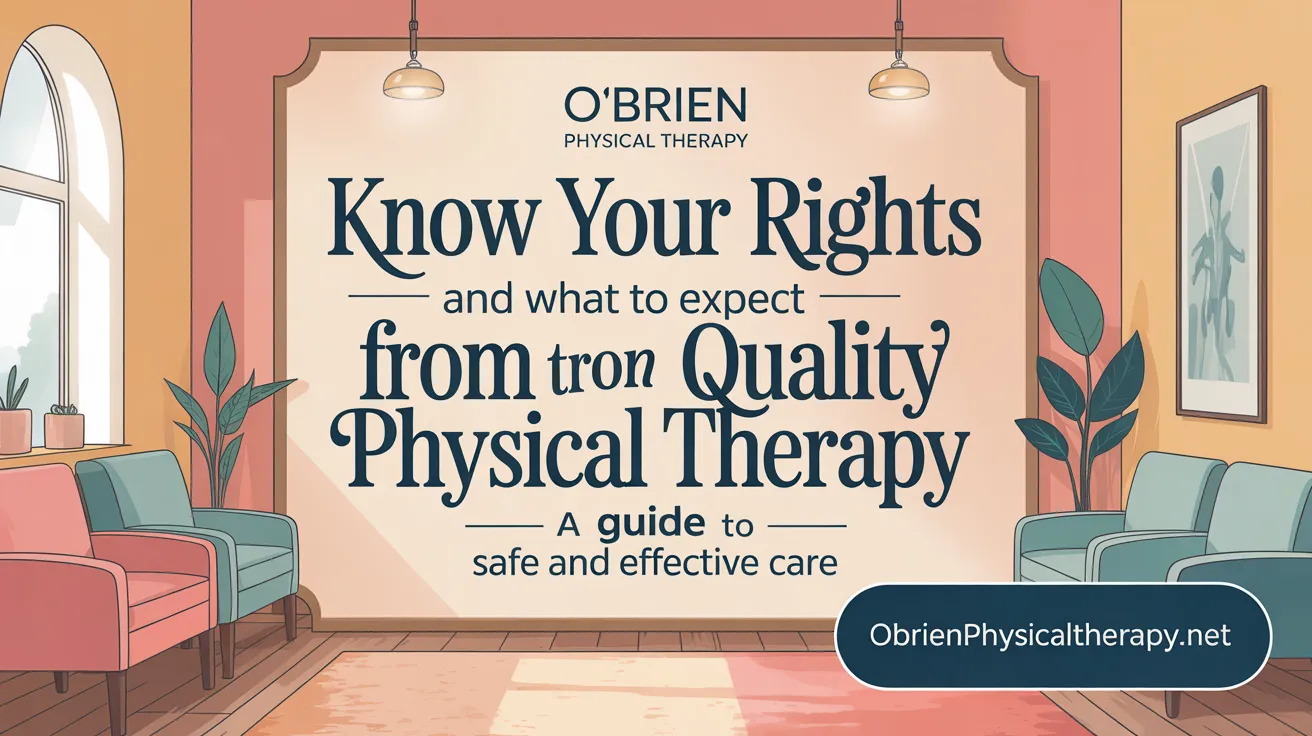Understanding the Importance of Choosing the Right Physical Therapist
Selecting the right physical therapist plays a crucial role in your recovery journey, mobility improvement, and overall quality of life. With a growing range of specialties, credentials, and treatment philosophies available, it’s important to navigate this decision informed and confident. This guide explores key considerations, qualifications, communication aspects, and practical tips to help you identify a physical therapist best suited for your specific health needs and goals.
Key Qualifications and Credentials to Look For
What qualifications and credentials should I look for in a physical therapist?
Selecting a skilled physical therapist begins with verifying their professional credentials and training. A qualified therapist must hold a valid license issued by the state, confirming they have met legal standards for practice. Most importantly, they should possess a Doctor of Physical Therapy (DPT) degree from an accredited university—assuring a comprehensive education in human movement, anatomy, and therapy techniques.
Many physical therapists pursue additional certifications to specialize in specific fields. Board certifications from recognized organizations, such as the American Board of Physical Therapy Specialties, indicate advanced training and expertise. These specialties include orthopedics, neurology, sports, geriatrics, pediatrics, and women’s health, among others. Having such certifications can be particularly beneficial if you have complex or specific needs.
Education quality is crucial. Ensure your prospective therapist graduated from an accredited program, typically recognized by the Commission on Accreditation in Physical Therapy Education (CAPTE) in the U.S.). This accreditation guarantees that the program meets rigorous academic and clinical standards.
Continuing education is also vital, as the field constantly advances. Look for therapists who regularly update their skills through courses, workshops, or advanced certifications in techniques such as dry needling, blood flow restriction therapy, or pelvic health. Such commitment evidences their dedication to delivering state-of-the-art care.
Additionally, assessing their experience with conditions similar to yours and their background in specialized techniques or equipment can guide you toward the right provider. During initial consultations, communication and rapport are also essential for a positive experience.
By verifying these professional qualifications—licensure, advanced certifications, accredited training, and ongoing education—you can select a trustworthy, competent physical therapist capable of providing effective, personalized care tailored to your health needs.
Evaluating Experience, Specialties, and Treatment Approaches
When seeking a physical therapist, understanding their experience and specialties is essential for effective care. Therapists often focus on areas like orthopedics, neurology, sports medicine, geriatrics, pediatrics, pelvic health, and more. For conditions such as chronic pain, sports injuries, or neurological impairments, choosing a practitioner with proven experience and relevant certifications can significantly impact recovery.
Manual therapy remains a fundamental technique in physical therapy. Skilled hand movements to manipulate soft tissues help reduce pain, improve flexibility, and decrease swelling. Evidence supports the effectiveness of manual approaches, particularly in treating musculoskeletal conditions. Many therapists incorporate evidence-based treatment methods, including electrical stimulation, biofeedback, dry needling, and innovative modalities like blood flow restriction training.
Creating a personalized treatment plan tailored to an individual’s goals is vital. Such plans typically combine manual therapy with targeted exercises, often incorporating home programs to reinforce progress. Thorough patient education is also emphasized, empowering individuals to continue beneficial activities outside of clinic sessions. These educational efforts include detailed instructions for stretches and strengthening activities, essential for conditions like plantar fasciitis, pulled groins, or post-surgical recovery.
A good therapist assesses specific needs and preferences, adjusting techniques accordingly. They should be attentive to your feedback, ensuring comfort and understanding throughout treatment. This personalized approach fosters trust, enhances motivation, and improves outcomes. When selecting a provider, consider their experience with your particular condition, their familiarity with current research, and their ability to develop an effective, individualized therapy plan.
The Role of Personal Connection and Communication in Therapy Success

Why is personal connection and communication with a physical therapist important?
Building a strong personal connection and ensuring effective communication with your physical therapist are crucial elements of successful therapy. When patients feel understood and supported, they are more likely to trust their therapist and stay motivated throughout their recovery journey.
Effective communication involves both speaking and listening. Techniques such as active listening, maintaining eye contact, and gentle touch help patients feel heard and valued. Clear explanations of treatment plans, progress, and expectations prevent misunderstandings and reduce anxiety, creating a more comfortable environment for recovery.
A good relationship with your therapist fosters mutual trust, which encourages open dialogue. Patients who feel connected tend to adhere more closely to prescribed exercises and lifestyle advice, leading to better outcomes.
Moreover, empathy and personalized care highlight that the therapist values individual patient needs. This supportive approach boosts motivation, making it easier to stay committed to the rehabilitation process.
During initial consultations, assessing how well your therapist communicates can help ensure a good fit. A therapist who listens carefully, explains thoroughly, and addresses your concerns demonstrates a commitment to patient-centered care.
Ultimately, strong personal bonds and clear communication enhance the entire therapeutic experience, resulting in quicker recovery, higher satisfaction, and better health results. Developing this rapport turns therapy from a routine appointment into a collaborative partnership focused on your success.
Practical Considerations When Selecting Your Physical Therapist
When choosing a physical therapist, practical factors play a significant role in ensuring effective and comfortable treatment. First, consider the clinic's location and accessibility. Conveniently located clinics increase the likelihood of attending all scheduled sessions consistently, which is vital for successful recovery.
Next, verify whether the clinic accepts your health insurance and understands their billing practices. Confirm if they will handle insurance claims directly, helping you avoid unexpected out-of-pocket expenses. It’s also wise to check if the clinic offers flexible scheduling options—such as evening or weekend appointments—to fit your personal timetable.
The clinic environment and available technology or equipment can impact the quality of care. Modern facilities equipped with tools like aquatic therapy pools, balance training devices, and electrical stimulation machines enable comprehensive treatment. Visiting the clinic beforehand can give you a feel for cleanliness, staff professionalism, and ease of access.
Additionally, virtual or telehealth physical therapy options are increasingly available. These can be effective for exercise-based therapies and offer the convenience of remote treatment, especially if you have mobility challenges or live far from clinics.
In summary, focus on selecting a licensed, experienced therapist with the right certifications for your condition. Ensure the clinic's location, hours, insurance compatibility, and treatment offerings meet your needs. A good rapport with your therapist, along with a supportive, well-equipped environment, can significantly influence your recovery experience.
Assessing Reviews, Reputation, and Feedback for Confidence in Care
When choosing a physical therapist, evaluating reviews, reputation, and patient feedback plays a crucial role in ensuring quality care. To do this responsibly, start by examining online ratings and testimonials on trusted platforms. Look for consistent comments about the therapist’s professionalism, effectiveness, and communication skills. Positive feedback that highlights personalized care and successful treatment outcomes can indicate a reliable provider.
In addition to patient reviews, seeking recommendations from healthcare providers, friends, or family members can provide valuable insights. Their experiences can help confirm a therapist’s expertise and bedside manner. It’s also beneficial to understand the peer review process. Peer reviews involve evaluations by qualified colleagues, which assess a therapist’s clinical decision-making, adherence to evidence-based practices, and overall quality of care.
Balancing patient feedback with professional peer assessments offers a comprehensive view of a therapist’s competence. While patient reviews reveal bedside manner and treatment satisfaction, peer reviews highlight clinical standards and safety practices. Be cautious of reviews lacking detail or that seem biased; instead, look for patterns and detailed accounts.
Red flags in reviews might include reports of unprofessional conduct, lack of progress, or inconsistent care. If such concerns arise, or if symptoms are severe, persistent, or unusual, seeking a physician’s input becomes necessary. Symptoms like rapid neurological decline, systemic signs of illness, or pain that does not respond to therapy may warrant medical evaluation.
Overall, combining multiple sources of feedback — reviews, recommendations, and peer evaluations — ensures a well-informed decision, giving confidence in choosing a therapist who can provide safe, effective, and compassionate care.
Your Rights as a Patient and Understanding the Scope of Physical Therapy

What is the scope of physical therapy services and what are my rights as a patient?
Physical therapy offers a wide range of services designed to evaluate, diagnose, and treat various movement-related issues. This includes hands-on manual therapy, tailored therapeutic exercises, and modern modalities such as ultrasound and electrical stimulation.
Additionally, physical therapists assist with wound care, provide training on assistive devices, and support overall health through education, community-based research, and management strategies.
As a patient, you have the right to choose your healthcare provider, including your physical therapist. You can access your medical records and participate actively in setting goals and making decisions about your treatment plan.
Patient safety and confidentiality are fundamental rights. Your therapy sessions should occur in a secure, respectful environment where your privacy is protected, and communication is kept confidential.
Physicians and licensed therapists are committed to delivering evidence-based care within their defined scope, adhering to legal and ethical standards.
You also have the right to know about potential risks, costs, and the specifics of your care plan.
If concerns or complaints arise, there are established mechanisms for reporting them, ensuring continuous quality improvement.
Overall, patients’ rights are reinforced through licensing laws, ethical codes of practice, and professional disciplinary measures, all aimed at safeguarding your health and ensuring high standards of care.
Making an Informed Choice for Optimal Recovery
Choosing the right physical therapist is a multifaceted decision that goes beyond credentials and experience. It requires assessing personal compatibility, communication quality, practical logistics, and professional reputation to ensure your unique health goals are met. Armed with knowledge about qualifications, treatment approaches, and your rights as a patient, you are empowered to select a therapist who not only meets the technical requirements but also supports you through a personalized and effective rehabilitation process. Remember to trust your instincts during consultations, seek recommendations, and consider the entire care environment to maximize your recovery success and improve your long-term wellness.
References
- Resource | Choosing Your Physical Therapist
- 5 Tips: How to Choose a Physical Therapist
- Choosing Your Physical Therapist
- How to Choose a Physical Therapist
- A PT's Tips on How to Choose a Physical Therapist
- How to Find a Physical Therapist - HSS
- What To Look For In A Physical Therapist | ATI
- 9 Tips for Choosing a Physical Therapist in Katy, TX - Spero Rehab
